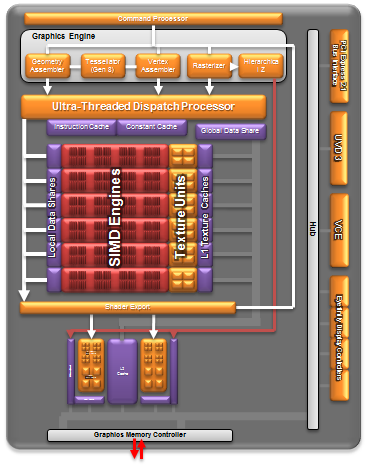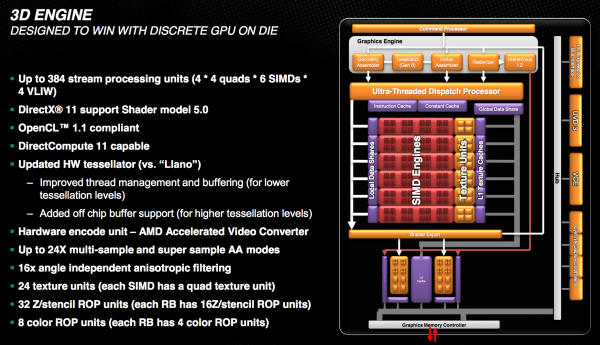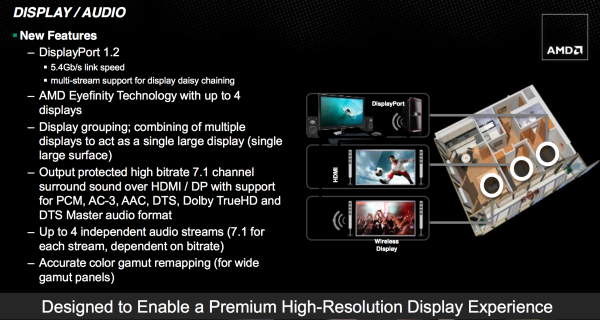The AMD Trinity Review (A10-4600M): A New Hope
by Jarred Walton on May 15, 2012 12:00 AM ESTImproved Turbo
Trinity features a much improved version of AMD's Turbo Core technology compared to Llano. First and foremost, both CPU and GPU turbo are now supported. In Llano only the CPU cores could turbo up if there was additional TDP headroom available, while the GPU cores ran no higher than their max specified frequency. In Trinity, if the CPU cores aren't using all of their allocated TDP but the GPU is under heavy load, it can exceed its typical max frequency to capitalize on the available TDP. The same obviously works in reverse.
Under the hood, the microcontroller that monitors all power consumption within the APU is much more capable. In Llano, the Turbo Core microcontroller looked at activity on the CPU/GPU and performed a static allocation of power based on this data. In Trinity, AMD implemented a physics based thermal calculation model using fast transforms. The model takes power and translates it into a dynamic temperature calculation. Power is still estimated based on workload, which AMD claims has less than a 1% error rate, but the new model gets accurate temperatures from those estimations. The thermal model delivers accuracy at or below 2C, in real time. Having more accurate thermal data allows the turbo microcontroller to respond quicker, which should allow for frequencies to scale up and down more effectively.
At the end of the day this should improve performance, although it's difficult to compare directly to Llano since so much has changed between the two APUs. Just as with Llano, AMD specifies nominal and max turbo frequencies for the Trinity CPU/GPU.
A Beefy Set of Interconnects
The holy grail for AMD (and Intel for that matter) is a single piece of silicon with CPU and GPU style cores that coexist harmoniously, each doing what they do best. We're not quite there yet, but in pursuit of that goal it's important to have tons of bandwidth available on chip.
Trinity still features two 64-bit DDR3 memory controllers with support for up to DDR3-1866 speeds. The controllers add support for 1.25V memory. Notebook bound Trinities (Socket FS1r2 and Socket FP2) support up to 32GB of memory, while the desktop variants (Socket FM2) can handle up to 64GB.
Hyper Transport is gone as an external interconnect, leaving only PCIe for off-chip IO. The Fusion Control Link is a 128-bit (each direction) interface giving off-chip IO devices access to system memory. Trinity also features a 256-bit (in each direction, per memory channel) Radeon Memory Bus (RMB) direct access to the DRAM controllers. The excessive width of this bus likely implies that it's also used for CPU/GPU communication as well.
IOMMU v2 is also supported by Trinity, giving supported discrete GPUs (e.g. Tahiti) access to the CPU's virtual memory. In Llano, you used to take data from disk, copy it to memory, then copy it from the CPU's address space to pinned memory that's accessible by the GPU, then the GPU gets it and brings it into its frame buffer. By having access to the CPU's virtual address space now the data goes from disk, to memory, then directly to the GPU's memory—you skip that intermediate mem to mem copy. Eventually we'll get to the point where there's truly one unified address space, but steps like these are what will get us there.
The Trinity GPU
Trinity's GPU is probably the most well understood part of the chip, seeing as how its basically a cut down Cayman from AMD's Northern Islands family. The VLIW4 design features 6 SIMD engines, each with 16 VLIW4 arrays, for a total of up to 384 cores. The A10 SKUs get 384 cores while the lower end A8 and A6 parts get 256 and 192, respectively. FP64 is supported but at 1/16 the FP32 rate.

As AMD never released any low-end Northern Islands VLIW4 parts, Trinity's GPU is a bit unique. It technically has fewer cores than Llano's GPU, but as we saw with AMD's transition from VLIW5 to VLIW4, the loss didn't really impact performance but rather drove up efficiency. Remember that most of the time that 5th unit in AMD's VLIW5 architectures went unused.
The design features 24 texture units and 8 ROPs, in line with what you'd expect from what's effectively 1/4 of a Cayman/Radeon HD 6970. Clock speeds are obviously lower than a full blown Cayman, but not by a ton. Trinity's GPU runs at a normal maximum of 497MHz and can turbo up as high as 686MHz.
Trinity includes AMD's HD Media Accelerator, which includes accelerated video decode (UVD3) and encode components (VCE). Trinity borrows Graphics Core Next's Video Codec Engine (VCE) and is actually functional in the hardware/software we have here today. Don't get too excited though; the VCE enabled software we have today won't take advantage of the identical hardware in discrete GCN GPUs. AMD tells us this is purely a matter of having the resources to prioritize Trinity first, and that discrete GPU VCE support is coming.















271 Comments
View All Comments
Burticus - Tuesday, May 15, 2012 - link
I wonder if they will release standalone mobile chips and if they are the same socket as the current Llano? Currently my laptop has an A8-3500 and I wouldn't mind upping to an A10.They did this in the past with the S1 socket, I wonder if it will be an option nowadays...
For the most part I've been pretty impressed with the A8 for a $500 laptop (especially with some overclocking). Games are playable at moderate settings. Civ 5 still kicks it in the teeth though, and I see that the A10 got a 10fps jump which would be nice.
JarredWalton - Tuesday, May 15, 2012 - link
The sockets are different: FS1r2 this time. I don't know precisely what changed, but apparently it's enough that AMD isn't making them backwards compatible.Fallen Kell - Tuesday, May 15, 2012 - link
The biggest problem with the design is that the OS doesn't know how to work with the CPU. Take the case where you have 2 of these piledrivers, with 1 floating point intensive job and 1 non-floating point intensive job already running, in which case the OS will place the first job, on one piledriver, and the next on the other piledriver. Then a user starts a new floating point intensive job, and the OS simply puts it on the next free core, which happens to be the one already running a floating point intensive application, and thus, you just bottlenecked both of those processes. The OS doesn't know if a process is floating-point heavy or not, and thus, can not properly schedule it to a core which has a floating point unit not in heavy use. That is why bulldozer failed. It is also why my work will never purchase it, as they do floating point intensive applications.Beenthere - Tuesday, May 15, 2012 - link
Most every reviewer has indicated that Trinity is a significant jump in performance in both CPU and GPU with extended battery performance yet some reviewers seem hard pressed to admit that for 90% of the laptop market Trinity is superior to Intel's best offerings.Some reviewers are trying to pretend that Intel's faster CPU performance some how is of importance to the majority of the laptop market when in fact it is not unless all you do is crunch numbers. I think Trinity sales just like llano and brazos will drive the point home who is leading the laptop market segment with what consumers actually desire.
JarredWalton - Tuesday, May 15, 2012 - link
Beenthere, you have to be the biggest AMD fanatic I've seen around here. EVERY article where AMD comes up, you're there making things up to justify your worldview. As I indicate in the article, Trinity is 10-20% faster than Llano on CPU and 20% faster on GPU, which is a decent improvement. Unfortunately, a lot of places are quoting AMD's "up to 29% faster CPU and 56% faster GPU" and calling it a day. Those are results that just didn't show up in any testing that I conducted.Oh, wait, I've got one: using OpenCL in GIMP, Trinity is 72% faster than Llano! There, we now have one statistic you can point to where Trinity is better. For the 0.1% of the population that uses GIMP, and not even them really -- it's the 0.1% of people that use GIMP and will some day benefit when the next major release comes out and incorporates OpenCL. If you can't see the problem with that statement, I can't help you.
For 90% of the market, Trinity might be enough, but to say it's "better than Intel's best" is pure fanaticism and nothing more. You are more biased than AMD's own marketing department. To pretend that moderately faster graphics with substantially less CPU performance is somehow more important than any other metric is insane. Sandy Bridge with GT 540M can be had for $600 right now, and it will beat Trinity in pretty much every single metric. Lucky for AMD, a lot of people like you will blindly purchase anything with AMD on it without regard for reality.
bji - Tuesday, May 15, 2012 - link
While I agree with your points overall, I think there is a fine detail you need to consider:Benchmarks are only an approximation of the performance results that would be achieved on a whole variety of processor tasks. You can rightly point out that only a small fraction of tested programs benefitted greatly from improved OpenCL performance, but you can't claim that this only benefits the 0.1% of people that use GIMP and care about OpenCL, because there may be other programs available now, or in the future, that would see similar performance increases. What your benchmarking shows is that *most* programs don't see a huge OpenCL performance benefit, but that *some* do. This is likely to lead to a more significant performance benefit than would be enjoyed by 0.1% of the users of a particular application.
However, I think that CPU reviewers are kind of in a hard place these days, since we're arguing over how big of an overkill one given processor is than another when considered for a wide variety of tasks, which starts to make any benchmarking about trying to find benchmarks where the performance difference would really matter. And that invites all kinds of debate about which kinds of performance actually matter to the average user, which is not a very fun or interesting argument.
CPU performance can still matter for targeted tasks, but that kind of analysis requires a very different approach and is very user-specific, when compared to standard benchmarking.
JarredWalton - Tuesday, May 15, 2012 - link
You're correct, and the real difficulty is first in finding anything where OpenCL is clearly faster, and then seeing similar techniques used in other software. Office for example isn't going to really get any faster because of you GPU or OpenCL -- and it doesn't need to be. Office spends its time waiting for user input. So what we really need are technologies that make the slow parts of using a computer faster. SSDs are a perfect example, because they make the initial boot and application load times all faster. OpenCL isn't doing that for the vast majority of applications, and neither is Quick Sync or DirectX or whatever other GPU related task you want to throw out there. They make graphics faster, but in my experience that's mostly important to gamers, or for high-end workstation stuff where you want OpenGL support.For many people, Core 2 Duo is fast enough, and Llano is fast enough, and Trinity is fast enough, etc. So for those users, it's about delivering the lowest cost. Trinity is twice the size of quad-core Ivy Bridge, so Intel could easily start a price war if they wanted, but they'd rather keep higher margins. Sandy Bridge laptops at $600 are still faster for general use than Llano and Trinity, particularly if they have an Optimus GPU around. Unless something is significantly faster in some important metric -- and I really don't see any single area where that's the case for Trinity -- then you just get whichever is the best price.
Beenthere - Tuesday, May 15, 2012 - link
Wow, Jarred is having an unhappy day! :(Obviously AMD's testing is different than your's as is other websites. My comments were NOT in regards to your article, which I though was pretty balanced. The website I was referring to is listed below.
Your knee-jerk reaction to my comment however shows you're loosing it. If you really believe that Intel's platform provides as good a result for mainstream consumers, you'd be in error especially when Trinty Ultrathins will be hundreds cheaper.
It's pretty obvious you can't deal with differing POVs and you get upset when you're opinion is not shared by others. Losing your objectivety makes it difficult for anyone to take your articles seriously - even though this one was pretty balanced. You should consider a CHILL PILL before over-reacting.
You really should THINK before you react. In this case my comment had NOTHING to do with your story. If your article has merit then you should not need to go POSTAL even if my comment was about your story. Being a reactionary and calling people names for having a different POV than you shows immaturity. The really funny part about your knee-jerk reaction was my comment was in regard to another story on Trinity on a different website. (see below).
You must have a guilty conscience? Below is the story I commented on. Oops, I'm sure you are embarrassed now, but it's OK? I don't hold grudges. <LOL>
Maybe the Intel fanbois are just beating you up too much because Trinity is a far better choice for laptops than anything Intel has at the moment? they'll get over it.
http://www.pcper.com/reviews/Mobile/AMD-A10-4600M-...
Cheer up Jarred. You can look forward to Piledriver/Vishera in a few months and more hate from the Intel fanbois.
bji - Tuesday, May 15, 2012 - link
Sorry, but when you start a paragraph with "Some reviewers are trying to pretend" you are VERY CLEARLY implicating that the reviewer is being dishonest by trying to mislead people reading the review by stating intentionally false commentary.If you start with that kind of premise, then you deserve a response that, in kind, accuses you of doing the same, which is exactly what you got.
Trying to then pretend that you're innocent and didn't deserve that response is just more lameness.
JarredWalton - Tuesday, May 15, 2012 - link
Beenthere is your typical passive aggressive anonymous Internet poster. I called him on his post, and now he backpedals. You know what's hilarious, Beenthere? That article you link. Let me give you a quote from the conclusion to show what I'm talking about:"I can’t find a way to look at Trinity that paints a favorable picture. Though certainly an improvement over Llano, it’s not enough. AMD is way behind Intel in processor performance, and the graphics performance does not offer redemption. The only way systems based off Trinity will be made competitive is by slashing and burning the prices."
Okay, that's pretty much what I said as well. Perhaps they're even more negative than I am. And yet... that paragraph is followed by a Silver Award? WTF is up with that? They're awarding something that they can't find a way to describe in a positive fashion? And then you suggest that "Some reviewers are trying to pretend that Intel's faster CPU performance some how is of importance to the majority of the laptop market when in fact it is not unless all you do is crunch numbers." I'd say the opposite: some reviewers are trying to kiss up to AMD with an award or backhanded praise when everything else they say is negative at best.
But hey, let's not forget how open and unbiased Beenthere is. Here's a quote from page three of the comments that shows his amazing analytical skills and not-at-all-anti-Intel mindset:
Subject: Excellent by Beenthere on Tuesday, May 15, 2012
As expected Trinity delivers in all areas and should meet most people's needs quite well. Good job AMD. You get my money!
Wow. Yup, Trinity is a far better choice for laptop than anything Intel has at the moment. Because Acer's AS4830TG with GT 540M and i5-2410M at $600 offers better CPU performance and better GPU performance. Yup. Far better. I like to pay more for less!